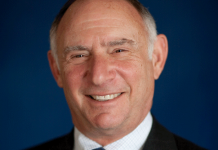By Alexei Koseff in The Sacramento Bee
When Gov. Jerry Brown took office eight years ago, he faced crippling budget deficits that required brutal cuts to public services.
Democrat Gavin Newsom, who won election Tuesday night, has a different kind of financial challenge as he prepares to assume the governorship in January: state coffers that are overflowing on the strength of a growing economy.
“When you’re in that situation, the pressures come to spend money,” said Allan Zaremberg, president and chief executive officer of the California Chamber of Commerce.
And the pressures are likely to come from all directions for Newsom, who raised more than $50 million as he cruised to victory, much of it from labor unions, corporations and other powerful groups with interests in Sacramento.
Newsom has already promised discipline in the “same mold” as Brown, who refashioned himself a fiscal moderate to put California’s finances back into order. Newsom points to his mayoral experience leading San Francisco through the economic recession a decade ago.
“I had to say ‘no’ more often than I said ‘yes.’ I was the proverbial adult in the room,” he told reporters at a campaign stop in Sacramento last week. “We made tough choices. That’s who I am, that’s who I’ve always been.”
Now he’ll have to decide once again which of his many political friends to disappoint. There is plenty they’d like to see done under his administration that Brown rejected or ignored.
One silver lining for Newsom: He will be the first Democrat in more than 130 years to succeed another Democrat as California governor. So the backlog of liberal priorities from lawmakers, organized labor, environmentalists and other supporters is not as extensive as it was, say, 20 years ago when Democrat Gray Davis took over from Republican Pete Wilson.
Expanding early childhood education
In the closing days of the campaign, Newsom put a heavy emphasis on his interest in expanding early childhood education, particularly establishing universal preschool in California. The Legislature will be eager to take him up on that promise. While Brown agreed to fund thousands more subsidized preschool and child care slots in recent years, he resisted efforts to make “transitional kindergarten” available to all low-income four-year-olds in the state, citing the cost. That remains a priority for legislative leaders like Assembly Speaker Anthony Rendon, who ran preschool programs for low-income children before he was elected.
Streamlining housing construction
No issue was more central to the gubernatorial election than California’s housing affordability crisis. While Brown has been criticized for failing to confront the problem, Newsom pledged to build 3.5 million new housing units by 2025, a goal that would require the state to quintuple its current rate of production. Developers and other business groups are eager for Newsom to revisit the local control and state mandates they say are squeezing them from both ends, driving up the cost of building homes.
“We have got to have a dramatic transformation in how local government approves new housing,” said Rob Lapsley, president of the California Business Roundtable. He cited lengthy regulatory reviews and “outrageous” fees on construction permits as major obstacles.
Developers are also hoping to scale back the opportunities for litigation under the California Environmental Quality Act, the state’s landmark environmental protection law that is often used to block projects in communities hostile to growth. And they want a freeze on new construction mandates, like those state regulators have adopted in recent years to make homes more energy efficient.
“We’ve got to slow down,” Lapsley said. “So much has happened in such a short time.”
Satisfying organized labor’s priorities
Organized labor plays an outsized role in California’s Democrat-dominated politics, and the state’s largest unions endorsed Newsom, helping propel him to substantial leads in the primary and general elections. Art Pulaski, executive secretary-treasurer for the California Labor Federation, said Newsom’s rise from “humble beginnings” would make him a strong ally to the labor movement as governor.
“I think in his gut he feels the challenges that working people have,” Pulaski said. “I have confidence that he will give justice to any issue of importance that we come to him with.”
At the top of the list is legislation to ban forced arbitration agreements, under which workers must give up their right to take disputes with their employer to court as a condition of the job. A longtime labor priority, the idea gained renewed traction this year amid the #MeToo movement against workplace sexual harassment; supporters argue that forced arbitration allows bad behavior to fester in secret. But Brown vetoed a bill, stating that the prohibition “plainly violates federal law.” Assemblywoman Lorena Gonzalez Fletcher, D-San Diego, who carried the measure, has already said she plans to reintroduce it.
Labor will also push again to extend collective bargaining rights to tens of thousands of state-subsidized child care providers. It would be the largest expansion of potential public employee union members in two decades; previous attempts were repeatedly rejected by Brown and his predecessor, former Gov. Arnold Schwarzenegger. “We want to see that day when a family child care provider isn’t nervous about catching a virus from a child because we will have health care benefits and we can go see a doctor,” Tonia McMillan, a provider and treasurer of SEIU Local 99, told the crowd Sunday at a labor barbeque and rally attended by Newsom. “California can afford it.”
As Newsom moves forward on his campaign promise to achieve universal health coverage in California, unions will be at the forefront of the debate over what that looks like. Health insurance for undocumented immigrants and policies to rein in prescription drug costs are on the agenda, but their objective is ultimately a government-run “single-payer” system. The California Nurses Association led the charge last year with an unsuccessful bill that Newsom backed — and then backed away from. For labor leaders, it’s not just a matter of principle, but an opportunity to remove one of the biggest costs to employers from the bargaining table.
“We’d much rather be able to negotiate that money into wages,” said Laphonza Butler, president of SEIU Local 2015.
Deciding who is an employee
A controversial California Supreme Court decision earlier this year threw decades of legal precedent in the air by establishing a new test for determining who is an employee. The business community, especially the tech industry, fretted over its implications for companies that run on independent contractors, while organized labor hailed the ruling as a rare win for workers who have been misclassified for years. A last-minute attempt to suspend the decision sputtered at the end of the legislative session, but it will be a prominent fight when the Legislature returns next year. Newsom could be caught between his business allies seeking relief and unions, who don’t want anyone to touch the ruling. “That might be the biggest test for his relationship with labor,” said David Huerta, president of SEIU United Service Workers West.
Reviving redevelopment agencies
To help balance the state budget, Brown in 2011 moved to eliminate California’s decades-old redevelopment program, which allowed cities and counties to take property taxes from blighted neighborhoods and use the money for projects to improve those areas. The arrangement cost the state about $5 billion annually to backfill tax revenues, mainly for schools, and abuses plagued many of the approximately 400 redevelopment agencies that existed statewide.
Local governments were not happy to lose the program, which also provided one of their major sources of funding to build affordable housing. Proposals for a replacement started cropping up in the Legislature almost as soon as redevelopment ended, though Brown was not interested.
Newsom, however, is open to it; his plan to spur more housing construction in California includes resurrecting redevelopment in some capacity. Lawmakers are already discussing what form that might take.
Erasing Jerry Brown’s veto pen
Brown signed thousands of bills during his tenure in Sacramento, but he didn’t leave everyone satisfied. His veto rate over his past two terms bounced between 10 and 15 percent, jumping this year to a record 16.5 percent. That leaves hundreds of ideas that lawmakers may be itching to revisit with a new governor at the helm.
Sen. Scott Wiener, D-San Francisco, intends to revive his proposal to push back closing time for bars to 4 a.m. Brown vetoed a measure that would have piloted the change in nine willing cities, arguing that California has “enough mischief from midnight to 2 without adding two more hours of mayhem.”
Sen. Anthony Portantino, D-La Cañada Flintridge, is moving ahead with his crusade to delay middle and high school start times until at least 8:30 a.m. Though the science is behind him, Brown dismissed the “one-size-fits-all approach” for a decision that he believed would be “best handled in the local community.” Newsom, with four young children of his own, may have a different perspective.
Advocates also hope the fourth time will be the charm for banning smoking at state parks and beaches. Brown rejected measures to do so each of the past three years, but Sen. Steve Glazer, D-Orinda, and Assemblyman Marc Levine, D-Greenbrae, are gearing up to try once again.
Increasing tax credits
Aside from establishing an anti-poverty tax credit and expanding a program meant to lure film and television production to California, Brown was generally reluctant to support legislation that allowed residents and businesses to reduce their state tax burdens. In 2015, he simultaneously vetoed nine bills to create new tax credits or bolster existing ones, warning of their collective impact on a “precariously balanced” budget. Sales taxes exemptions on goods like diapers and animal blood also fared poorly.
Now proponents will have an opportunity to test whether Newsom is any more receptive to their requests, particularly on issues that align with his liberal social agenda. Assemblywoman Cristina Garcia, D-Bell Gardens, is ready to bring back her proposal to eliminate the sales tax on tampons and other menstrual products, which received nearly unanimous approval from lawmakers in 2016 before it was rejected by Brown.




